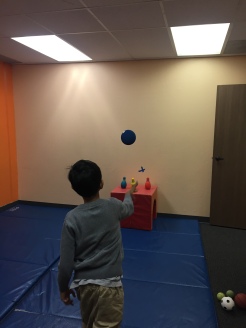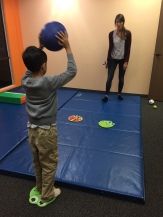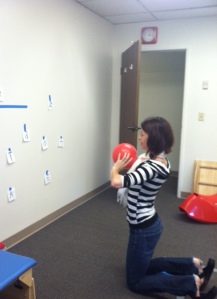Are you working on ball skills with any of your kids? Looking for ways to mix it up? At one of our recent group sessions, we had the kids play ‘Carnival Games.’ They were working on the same skills but we changed the context and to them, it was a whole different ball game (pun intended)!
Here were some of the games we did (we’d love to hear of any suggestions you might have so we can add to our repetoire):

- Bowling – Line the pins up and have the kids practice underhand bowling. They get two chances to get the pins down. You can add visual cues such as a tape line to help them with their aim. Or two staggered spots to help them with their stepping into the roll. You can also change the size of the ball. They could start with a larger ball and use two hands to roll it (sometimes this helps them understand the concept of rolling a little easier). As they progress the ball can get smaller. For a real challenge have them stand on one foot or in tandem stance (one foot in front of the other) so they can work on their balance.
- Knock the Cans Down – I’m sure there is a more official carnival name but we’ll just go with this! You can stack cups into a pyramid or you can use bowling pins like we did and recreate the bowling formation. They get two chances to knock everything down. As you can see we also added a visual cue behind the pins to help with aiming. You can use staggered spots on the floor to help with stepping into the throw. You can switch it up and work on overhand or underhand throwing. To challenge the balance, just like with bowling, you can do single leg stance, tandem stance, or you could stand on an unstable surface like a balance board or a pillow.

- Bucket Toss – With this one the child is trying to get as many balls into the bucket as they can. They get a point for each one. You can mix it up if you want to work on underhand or overhand throwing. And you can challenge balance just like in Knock the Cans Down! Change the size of the ball or the density of the ball. You can use an o-ball for easier gripping or a ball that is deflated slightly to make it easier to hold onto. Lots of ways to vary the activity. And, you can use the visual cue on the wall to help with aiming!
- Hit the Spot – This game works on passing skills. You can put one or multiple spots on the ground and have the child work on bounce passing the ball to you while trying to hit the spot. Pick a number of times and they get a point for every time they hit a spot. If you are using multiple spots you can increase the challenge of the game by calling out what spot you want them to hit when they pass it. It also works on catching because you will be passing the ball back to them. They can have some fun with telling you what spot to hit also!
What are some other games you would include in your Carnival Games?






